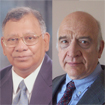
Dr. K. L. Mittal, Dr. Robert H. Lacombe
Welcome to our new blog: It is our pleasure to contribute to the Plasmatreat blog site a section dealing with various aspects of surface science and technology and how it impacts various day to day projects dealing with product development and manufacturing. In this regard we have chosen to label the blog as the SURFACE SCIENCE CORNER.
Though the Plasmatreat site deals mainly with issues confronting the open air plasma technology the general aspects of surface science play a vital role in the ultimate success or failure of this methodology as it does also with all other surface modification techniques. Thus the material presented will deal with a fairly wide range of issues of both direct and indirect relevance to the treatment of surfaces with plasmas.
INTRODUCTION
As this is the inaugural issue of the blog it is appropriate that we give a short resume of our backgrounds and how they relate to surface science.
We are Drs. Mittal and Lacombe and our interest and expertise in surface science stems from some 30 years experience in the microelectronics industry. A typical microchip device can consist of a dozen or more layers of insulator, semiconductor and metal materials each on the order of a micrometer or less in thickness. Thus a sizable fraction of the structure can be considered as either a surface or an interface between two surfaces thereby giving rise to a wide range of interactions not all of which are amicable to the overall stability of the device. The microelectronics industry was in fact one of the first to utilize plasma technology on a wide scale both for cleaning purposes and for etching fine lines in photoresists.
Dr. Mittal has mainly focused on writing about and carefully documenting the various aspects of surface science and how they impacted microelectronic technology. He was editor of the Journal of Adhesion Science and Technology from 1987 to 2012 and has also edited over 100 volumes dealing with surface cleaning, adhesion, high temperature polymers, thin films, surface analytical methods and surfactants in solution. This long experience has given him an encyclopedic knowledge of a wide range surface science topics and, very recently, he has started a new journal called Reviews of Adhesion and Adhesives (RAA).
Dr. Lacombe, while sharing the same office with Dr. Mittal for some 7 years, was more a man of the laboratory setting up equipment, performing experiments and carrying out large scale calculations of the thermodynamic stability of multilevel laminate structures. He was among the first investigators to measure the thermal-mechanical properties of 2 nanometer thick monolayer films which were being investigated as the ultimate photoresists already in the early 1980’s. He was also heavily involved in the field of adhesion measurement and has written the only volume dedicated solely to this topic (Adhesion Measurement Methods: Theory and Practice, CRC Press, 2006).
TOPICS
Let us now conclude this introduction with a brief list of the types of topics that will be covered in future issues. Among the topics of most interest are:
ADHESION: One of the primary uses of plasma technology is to alter the chemistry of a surface in such a way as to increase the surface energy and thus significantly improve the adhesion of candidate coatings. Plasma technology has been very effective in this regard. However, it is also important to know whether the level of adhesion achieved is sufficient for the purpose at hand so the topic of adhesion measurement will also be an important consideration.
SURFACE CLEANING: Surface cleaning is another important application of plasma technology and it is also critical to ascertain the level of cleaning attained to know whether it is sufficient or not. Thus measuring surface cleanliness is a further important issue.
SURFACE ANALYTICAL METHODS: The ability to analyze the chemical and physical nature of a surface is of course critical to both of the above mentioned topics. Thus attention will be paid to the various analytical methods used to investigate surface chemistry such as X-ray Photoelectron Spectroscopy (XPS also going under the alias Electron Spectroscopy for Chemical Analysis, ESCA). The thermodynamic nature of surfaces is effectively investigated through the use of CONTACT ANGLE measurements. This rather prosaic measurement technique, though rather simple in concept, is quite subtle in practice and can provide a wealth of valuable information on the physico-chemical nature of surfaces.
BOOK REVIEWS: Our office receives a number of volumes dealing with all aspects of surface science. From time to time when a particularly relevant volume is received it will be brought to the attention of readers of this blog by way of a critical review.
REVIEWS OF IMPORTANT CURRENT RESEARCH: By way of keeping up to date on all aspects of surface science we organize each year through MST CONFERENCES up to 4 symposia which cover the latest developments in this field. From time to time a particularly relevant presentation will be given and such will also be brought to the attention of readers again through a critical review.
Finally let us conclude with a few remarks concerning the style and presentation level of this blog series. Our basic aim will be to make what is arguably a rather esoteric topic clear and understandable to the non-expert by giving concrete examples and also by avoiding technical jargon to the greatest extent possible. Thus we aim for what might be construed as a SURFACE SCIENCE FOR DUMMIES writing style. The aim, therefore, will be to make surface science topics clear and understandable to a range of individuals who have a need to know this topic but may not have either the background or time to pursue the matter at the level of the technical literature. A famous professor once told a student that if he could explain his work to a barmaid then he indeed knew what he was talking about. We will strive to achieve that level of clarity to the greatest extent possible.
Again we are thankful for the opportunity to contribute to the Plasmatreat blog and we hope all readers will find topics of interest and enjoyment therein.
Best Regards,
Dr. K. L. Mittal, Dr. Robert H. Lacombe
Recommend






Write a comment